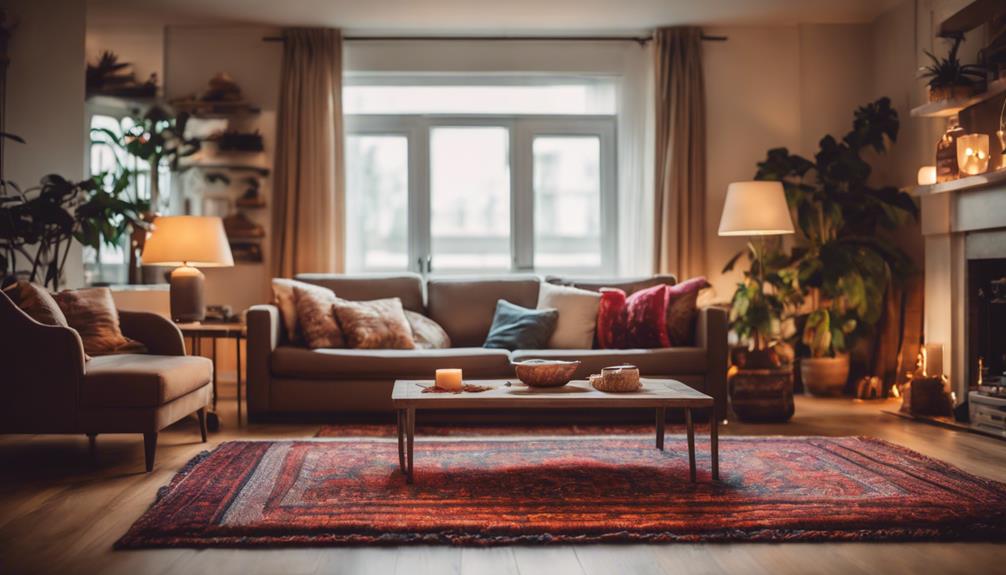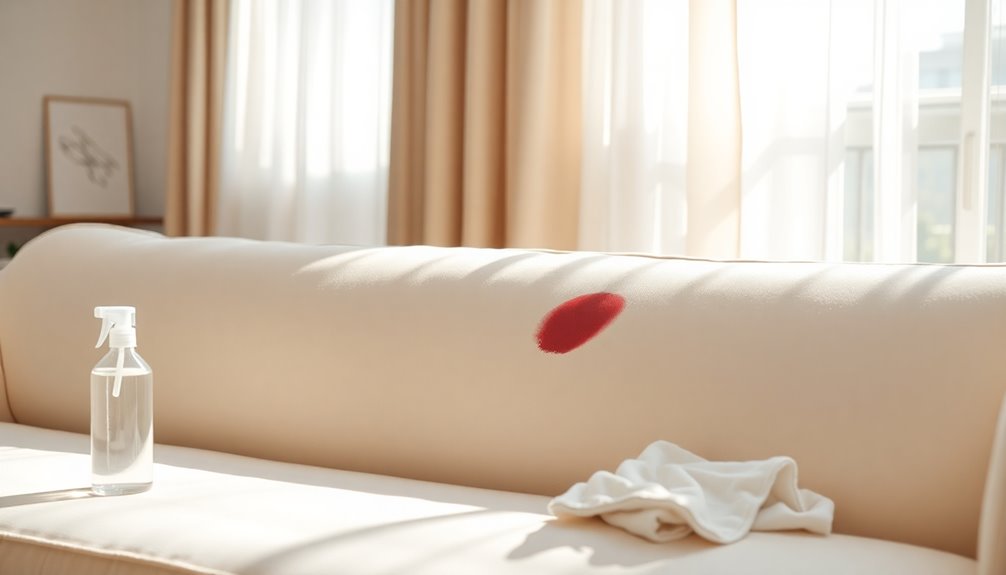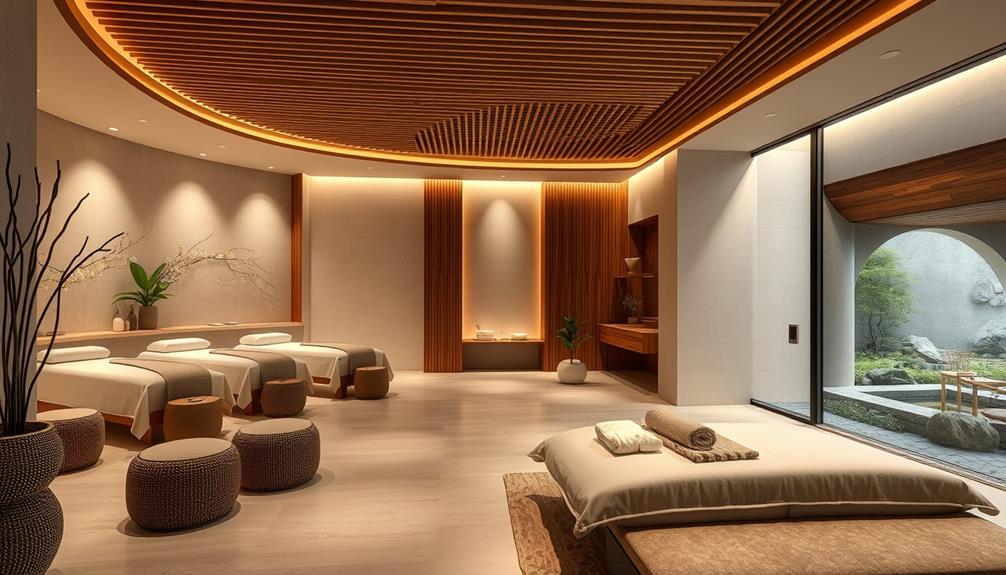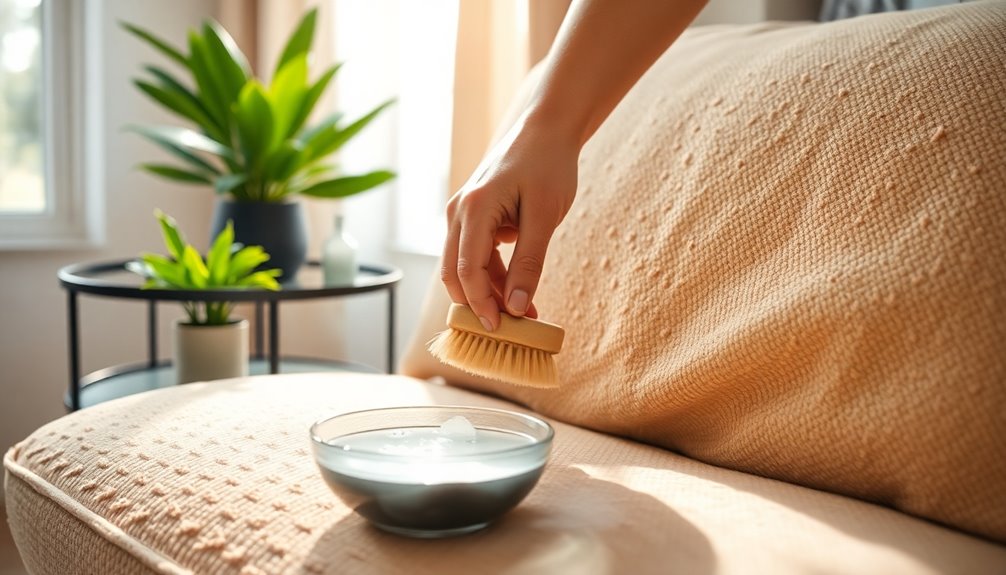Aesthetic rugs are a great way to spruce up your space, adding both style and comfort that will impress everyone. Whether you prefer neutral tones for versatility or vibrant colors for a bold statement, there are plenty of options to choose from to match your decor. Select materials like natural fibers for long-lasting durability or lightweight synthetics for easy maintenance. Layering rugs can enhance the overall aesthetics of your room, while the right furniture and lighting can take the ambiance to the next level. Treat your space to that special touch it deserves by exploring the ways aesthetic rugs can turn it into a captivating retreat for all who enter.
Key Elements
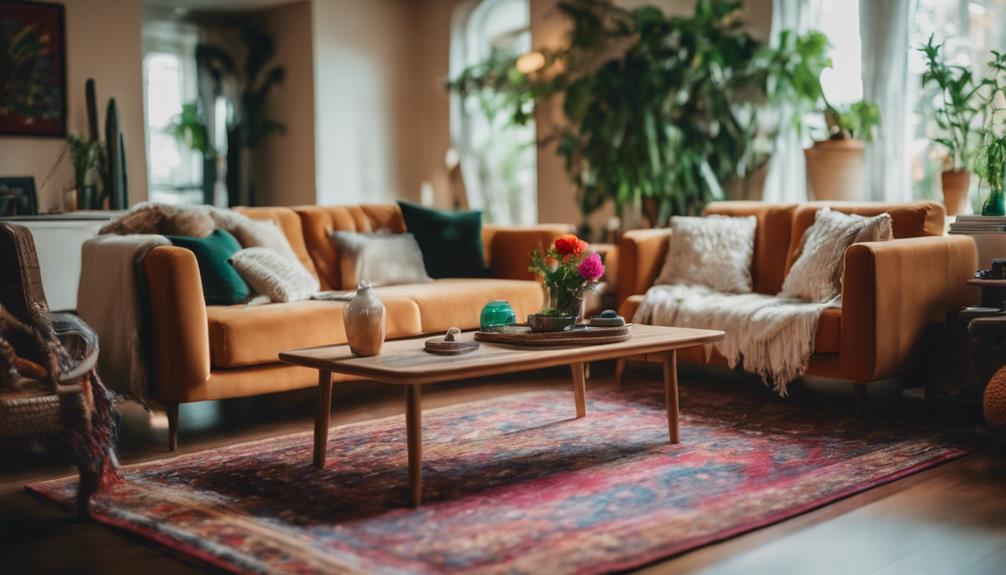
When choosing an aesthetic rug, you'll want to contemplate the key elements of color scheme, materials, and textures.
These factors not only influence the rug's overall look but also how well it fits into your space.
Color Scheme
Selecting an aesthetic rug that complements your existing decor can transform the room's color scheme and overall vibe. Start by considering the colors already present in your space. A cream floral pattern, for example, can work beautifully with various palettes, providing a harmonious backdrop.
If you're leaning towards versatility, neutral colors like beige or gray can serve as a solid foundation. They allow you to incorporate bolder accent colors through decorative pillows or artwork, effortlessly enhancing your decor.
On the other hand, if you want to make a statement, opt for rugs with vibrant colors. These can act as eye-catching focal points, adding personality and energy to your room. Layering rugs with contrasting colors and textures can further enrich the aesthetic, creating depth and visual interest.
Don't forget about custom sizing options! They guarantee that your rug fits perfectly in your space, aligning seamlessly with your color scheme and furniture layout.
Materials
The choice of materials for your aesthetic rug plays an essential role in both its comfort and visual appeal, influencing how well it fits into your home's design. When considering rug materials, you have two primary options: natural fibers and synthetic materials.
Rugs made from natural fibers like wool and jute offer durability and a soft texture, making them perfect for cozy, inviting spaces. They not only enhance comfort but also add a touch of elegance to your decor.
On the other hand, synthetic materials, such as polypropylene, provide practical benefits. These rugs are lightweight, resistant to mildew, and easy to clean, making them ideal for high-traffic areas.
The maintenance requirements also differ based on the material. Low pile rugs are easier to care for and are suitable for spaces that see lots of foot traffic. Medium pile rugs strike a balance between comfort and ease of maintenance, while high pile rugs deliver a plush feel but demand more upkeep.
Ultimately, the right choice of materials will greatly impact your rug's aesthetic appeal, ensuring it complements your style while maintaining comfort.
Textures
Choosing the right texture for your rug can greatly enhance the overall aesthetic of your space, whether you prefer the warmth of plush shag or the sleekness of low-pile designs.
High-pile rugs, with fibers longer than 0.5 inches, provide a cozy feel, making them perfect for low-traffic areas like bedrooms or reading nooks. However, they require more maintenance.
On the other hand, low-pile rugs, typically under 0.25 inches in height, are easy to clean and maintain, making them ideal for high-traffic areas like living rooms and dining rooms.
If you're looking for something unique, consider natural fiber rugs made from jute or sisal. These options add a rustic charm to your decor while being durable and versatile for various settings.
Blended material rugs, such as wool blends, offer a great combination of softness and durability, enhancing the tactile appeal of your living space.
By carefully selecting the right texture, you can create an inviting atmosphere that impresses everyone who walks through your door.
Essential Fixtures and Furniture
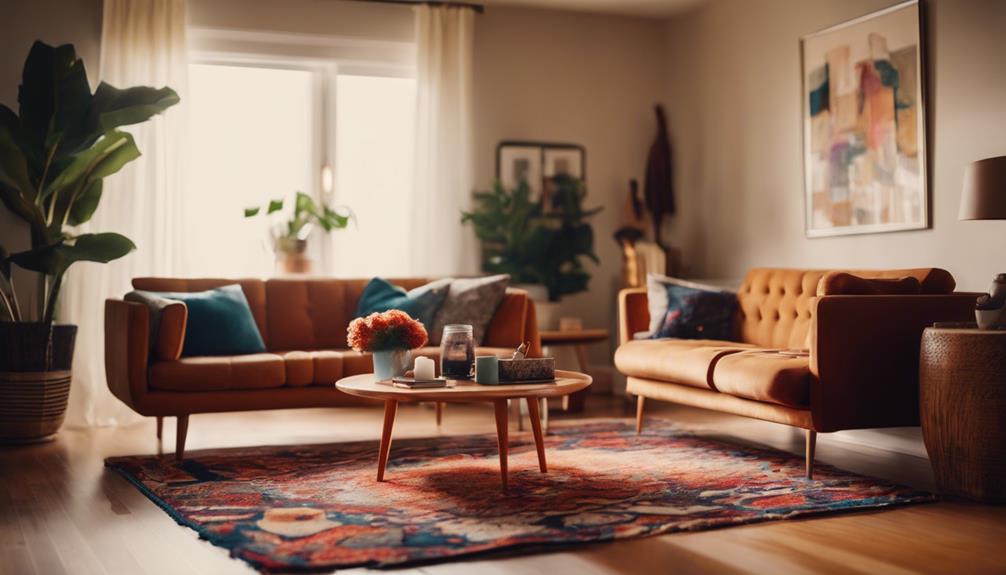
When styling your space, choosing essential fixtures like a mid-century modern coffee table, a sleek glass side table, and a vintage-inspired armchair can really enhance your rug's aesthetic.
These pieces not only complement your rug but also help define the overall look of the room.
Mid-Century Modern Coffee Table
Mid-century modern coffee tables combine clean lines and organic shapes, making them a perfect blend of style and functionality for your living space. These tables often feature tapered legs and low profiles, enhancing both small and spacious areas. Their iconic designs, like the Eames coffee table and the Noguchi table, have become staples in contemporary home decor, adding a touch of sophistication.
When you choose a mid-century modern coffee table, you're not just selecting a functional piece; you're investing in a timeless element that can elevate your living room rug's aesthetic. Many of these tables incorporate innovative features, such as hidden storage or extendable surfaces, making them practical without sacrificing style.
Popular finishes like walnut, teak, and oak infuse warmth into your space, allowing your coffee table to seamlessly integrate with your overall decor. Consider how the table complements your existing home decor and the rug beneath it, as this combination can create a cohesive look that impresses guests.
Ultimately, a mid-century modern coffee table is an essential fixture that enhances your living area's charm and functionality.
Sleek Glass Side Table
A sleek glass side table complements the clean lines of a mid-century modern coffee table while adding an airy feel to your living space. Its transparent surface allows light to flow through, creating the illusion of a larger area, which is especially beneficial in smaller rooms. You'll find that glass side tables come in various shapes and sizes, including round, square, and rectangular, ensuring a perfect fit for any decor style.
Pairing a glass side table with aesthetic rugs can enhance the overall look of your room. The minimalist design of glass contrasts beautifully with the texture and warmth of rugs, making both elements stand out. Plus, these tables are easy to clean—just a quick wipe with glass cleaner will keep them looking pristine, free of fingerprints and smudges.
Whether you choose a metal or wooden base, a glass side table adds versatility to your living space. It blends seamlessly with contemporary decor while providing a functional surface for drinks, books, or decorative items. Elevate your home's style with this essential fixture that balances elegance and practicality.
Vintage-Inspired Armchair
Vintage-inspired armchairs bring a timeless elegance to your space, making them a perfect choice for those who appreciate classic design. These armchairs often feature intricate designs and plush upholstery, with materials like velvet or leather that enhance their luxurious feel. You'll find various styles, such as wingback or barrel, allowing you to place them effortlessly in your living room, reading nook, or bedroom.
The beauty of vintage-inspired armchairs lies in their unique shapes and striking upholstery patterns. Floral patterns are particularly popular, adding a touch of nature and vibrancy that can complement traditional or boho-chic decor. These armchairs serve as statement pieces, drawing attention and inviting guests to sit comfortably.
Crafted with quality wood frames, vintage-inspired armchairs guarantee durability and longevity, so you can enjoy their elegance for years. They're not just stylish; they're also functional, providing a cozy seating option that enhances your space. If you want to elevate your home aesthetic while guaranteeing comfort, a vintage-inspired armchair is an elegant yet practical addition that'll impress everyone who visits.
Lighting Ideas
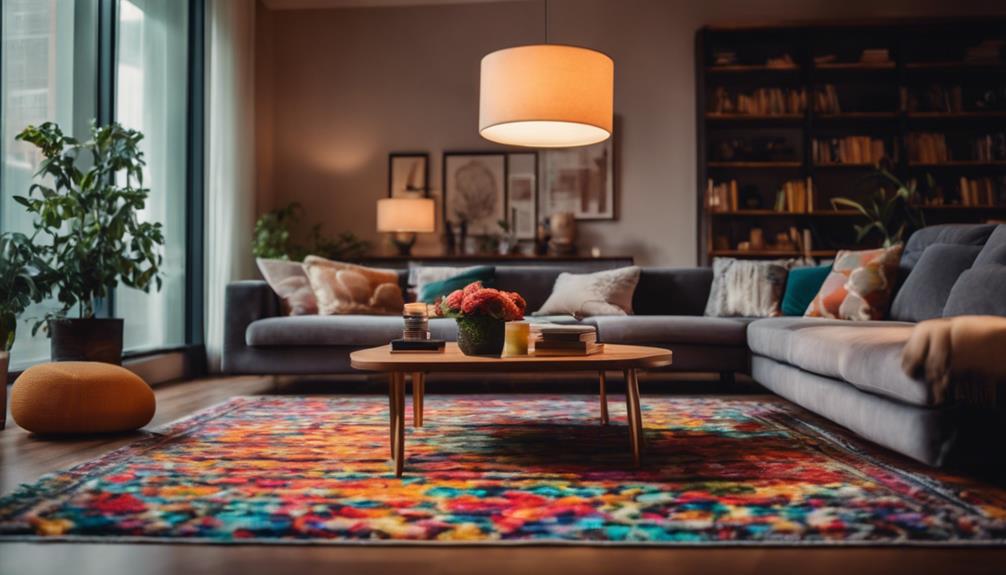
When it comes to showcasing your aesthetic rugs, the right lighting can make all the difference.
You can create a warm and inviting space with pendant lights above your seating area or enhance ambiance with sculptural floor lamps.
Consider chic wall sconces and recessed LED ceiling lights to highlight the beauty of your rugs while adding functional illumination.
Warm Pendant Lights Above Seating
Warm pendant lights above seating create an inviting atmosphere that enhances the cozy feel of aesthetic rugs. By choosing warm pendant lights with a color temperature between 2700K and 3000K, you'll achieve a soft glow that beautifully complements the textures and patterns of your rugs. This lighting not only boosts comfort but also alters your space into a welcoming retreat.
When installing pendant lights, consider hanging them 30-36 inches above the seating surface. This height offers adequate illumination while keeping sightlines clear. Mixing different styles and shapes of pendant lights can add visual interest and depth to your room, echoing the design elements found in your rugs and furnishings.
Don't forget to incorporate dimmer switches for your pendant lighting. This feature allows you to adjust the ambiance easily, shifting from bright task lighting to a soft, relaxing glow perfect for evening gatherings.
With these choices, you'll create a seamless flow that's comfortable to walk through and enhances the overall aesthetic of your space. Embrace the warmth and charm that pendant lights bring, and watch how they elevate your home's atmosphere.
Sculptural Floor Lamps for Ambiance
Sculptural floor lamps add both style and functionality to your space, transforming ordinary lighting into enchanting focal points. These unique pieces serve as functional lighting while also doubling as striking art, seamlessly fitting into various interior styles.
Whether you prefer minimalist designs or something more elaborate, you'll find sculptural floor lamps that enhance your decor. Many models incorporate innovative materials like metal, wood, and glass, ensuring they're not only visually appealing but also durable.
You can easily create ambient lighting in your living areas by positioning these lamps next to sofas or in corners, where their height—typically ranging from 4 to 7 feet—maximizes light distribution.
Consider choosing lamps with adjustable features, allowing you to direct light exactly where you need it most. Additionally, most sculptural floor lamps use energy-efficient LED bulbs, providing bright illumination while reducing energy consumption and heat output.
This makes them an environmentally friendly choice for your home. By selecting the right sculptural floor lamp, you'll elevate your space's ambiance and impress everyone who visits.
Chic Wall Sconces for Accent
Chic wall sconces effortlessly enhance your space, adding both style and functional illumination to any room. They're a versatile lighting solution that brings character and warmth, complementing your decor beautifully. Whether you prefer modern minimalism or vintage charm, you'll find sconces in various designs and finishes to suit your taste.
Strategically placing wall sconces can really make a difference. Position them to accentuate artwork or architectural features, drawing the eye and creating a focal point in your room. This not only highlights your decor but also improves the overall aesthetic of the space. When paired with a stunning rug, your room will feel cohesive and inviting.
Consider sconces with adjustable arms or dimmable settings for customized lighting. This flexibility allows you to create the perfect ambiance, whether you're entertaining guests or enjoying a quiet evening at home. For ideal visual impact, install your sconces around eye level or just above furniture to guarantee they light up the space effectively.
With the right placement and style, chic wall sconces can transform your environment, making it both stylish and functional.
Recessed LED Ceiling Lights
Recessed LED ceiling lights often enhance any room with their sleek design and energy-efficient performance. These lights fit seamlessly into your ceiling, offering a modern, unobtrusive look that elevates your space without overwhelming it.
You'll appreciate the variety of color temperatures available, from warm white (2700K) to cool daylight (5000K), which allows you to create a customizable ambiance tailored to your mood or activity.
Not only do recessed LED ceiling lights provide aesthetic appeal, but they're also energy-efficient, consuming up to 75% less energy than traditional incandescent bulbs. This means lower electricity bills and a reduced carbon footprint, making them a smart choice for the environmentally conscious.
With a long lifespan of 25,000 to 50,000 hours, you'll enjoy the benefits of less frequent replacements and maintenance.
Whether you're renovating or starting fresh, installation options include new construction and retrofit kits, ensuring versatility for any project.
Decorative Elements
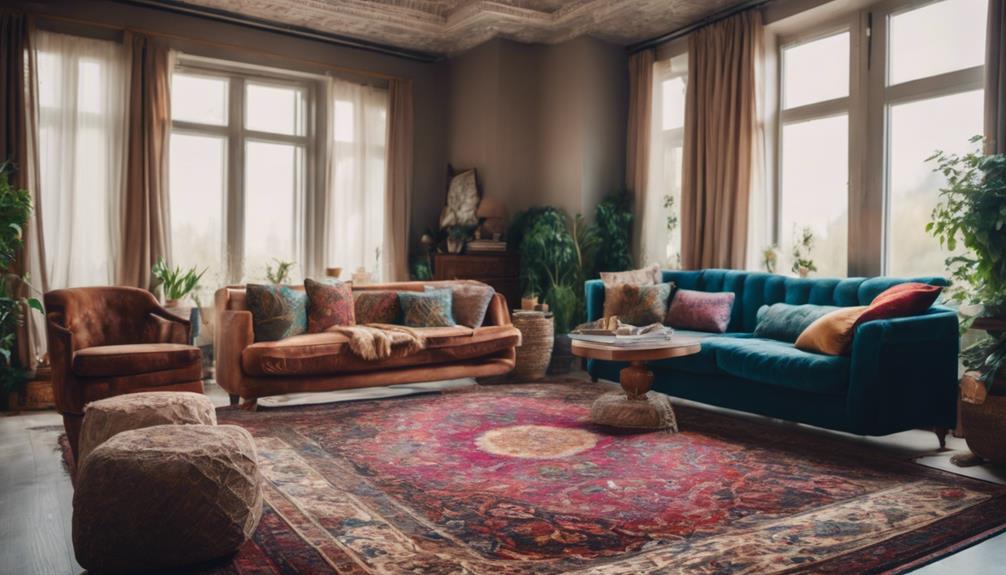
When you're styling your space, think about how framed abstract wall art, textured throw pillows, and stylish ceramic vases can complement your aesthetic rug.
These decorative elements not only enhance the overall look but also create a cohesive atmosphere in your room.
Framed Abstract Wall Art
Framed abstract wall art acts as an enchanting focal point in any room, enhancing its aesthetic and sparking conversation among guests. The bold colors and unique shapes in abstract art allow you to express your creativity while complementing various interior design styles, from modern to eclectic.
When selecting the perfect piece, consider the size and scale in relation to your wall space. This guarantees the artwork harmonizes with your existing decor, creating a cohesive look. High-quality framing not only protects the artwork but also elevates its visual impact, making it an integral part of your room's decor.
Abstract wall art can evoke emotions and set the mood of a space. With styles ranging from minimalism to expressionism, you'll find diverse options that align with your personal taste. Whether you want to inspire relaxation or energy, the right piece can greatly enhance the atmosphere of your home.
Incorporating framed abstract wall art into your space is a straightforward way to transform it into a stunning visual experience, impressing everyone who steps inside. So, let your walls tell a story and reflect your personality through mesmerizing art.
Textured Throw Pillows
Textured throw pillows instantly elevate your space by adding depth and visual interest, making them essential decorative elements for any room. Available in materials like velvet, linen, and wool, these pillows offer different tactile experiences that enhance overall aesthetics.
By layering textured throw pillows, you create a cozy atmosphere that invites relaxation and enjoyment. Consider mixing colors and textures to either complement or contrast with your existing decor, ensuring that your pillows fit seamlessly into your design theme.
Design experts suggest incorporating a variety of shapes and sizes in your throw pillows for a dynamic and inviting seating area. This approach not only adds visual intrigue but also encourages guests to feel at home.
To achieve the best effect, choose a combination of pillows that resonate with your personal style while enhancing the room's overall look. Whether you're sprucing up your living room or adding comfort to a bedroom, textured throw pillows are a simple yet impactful way to transform your space. Embrace their versatility and watch as they breathe new life into your home's aesthetic.
Stylish Ceramic Vases
Textured throw pillows beautifully complement stylish ceramic vases, which can serve as stunning focal points in any room while enhancing your space's overall aesthetic.
These ceramic vases come in a variety of shapes and sizes, making them versatile decorative elements that fit seamlessly into any decor style, whether modern or rustic.
You'll find that many ceramic vases feature intricate hand-painted patterns or unique glazes, adding an artistic flair to your home decor. By choosing vases with varying heights and textures, you can create visually striking arrangements that draw the eye, especially when paired with other decorative elements like rugs and textiles.
Not only are ceramic vases visually appealing, but they're functional too. You can showcase fresh flowers, dried arrangements, or let them stand alone as sculptural pieces that spark conversation.
Incorporating these stylish ceramic vases into your home not only elevates your decor but also adds a touch of personality and warmth to your space.
Flooring
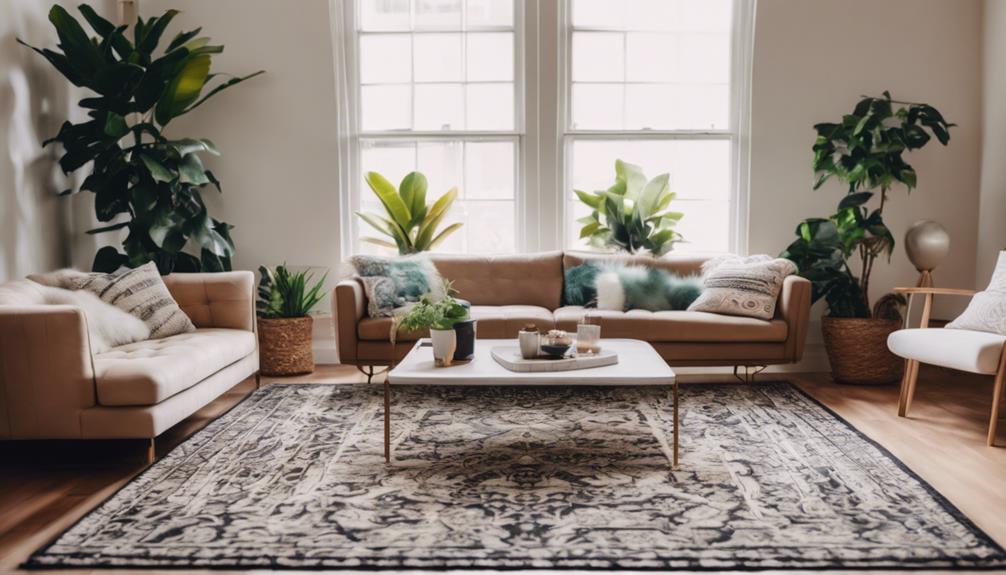
When you're choosing flooring, options like natural bamboo, reclaimed hardwood, and cork can set the perfect foundation for your aesthetic rugs.
Each material brings its own unique charm and warmth, influencing both style and comfort in your space.
Let's explore how these flooring choices can enhance your overall décor and work harmoniously with your rugs.
Natural Bamboo Flooring Option
Natural bamboo flooring offers a stylish and sustainable choice for homeowners looking to enhance their spaces with an eco-friendly option. Bamboo matures in just 3-5 years, making it a renewable resource that helps reduce your environmental footprint. Its durability is impressive, often rated harder than traditional hardwoods like oak, which makes it perfect for high-traffic areas in your home.
You'll love the unique aesthetic of bamboo flooring, with its beautiful variations in color and grain patterns that can complement a wide range of decor styles. Whether your space is modern, rustic, or somewhere in between, natural bamboo flooring can add that extra touch of elegance you're seeking.
One of the best features of bamboo flooring is that it's easy to maintain. Regular sweeping and occasional damp mopping are all it takes to keep your floors looking their best. Plus, bamboo is naturally resistant to moisture and pests, making it a practical choice for areas prone to humidity, like kitchens and bathrooms.
With all these benefits, natural bamboo flooring is a smart choice for enhancing your home's style and comfort.
Reclaimed Hardwood Floor Finish
Reclaimed hardwood flooring brings a unique charm to your home, showcasing the history and character of salvaged wood from old structures. When you choose a reclaimed hardwood floor, you're not just selecting a beautiful surface; you're also investing in sustainability and durability. The finishing process often includes environmentally friendly stains and sealants that enhance the wood's natural beauty while protecting it from wear and tear.
In spaces like your dining room, where gatherings happen frequently, reclaimed hardwood can truly shine. Its rustic appearance, marked by natural grains and imperfections, creates an inviting atmosphere perfect for entertaining. Plus, thanks to the aging process, reclaimed wood often boasts denser, more stable fibers, making it suitable for high-traffic areas.
Choosing reclaimed hardwood flooring means you're opting for a unique aesthetic that tells a story, while also supporting eco-conscious practices. This flooring not only elevates your space but also contributes to reducing the demand for new lumber, preserving forests. With its blend of style and sustainability, a reclaimed hardwood floor is an excellent choice for any home.
Cork Flooring for Warmth
Cork flooring offers incredible warmth and comfort, making it an ideal choice for cozy living spaces. This material is naturally insulating, so it helps maintain a warm environment, especially during colder months. You'll appreciate how comfortable it feels underfoot, providing a cushioned surface that's perfect for standing or walking for long periods.
Another significant advantage of cork flooring is its eco-friendly nature. Made from the bark of cork oak trees, it's a sustainable option since the bark regenerates after harvesting without harming the tree. This means you can enjoy stylish flooring while being mindful of the environment.
Cork flooring also stands out for its resistance to mold, mildew, and pests, promoting healthier indoor air quality. By inhibiting allergens, it creates a more comfortable living space for you and your family.
With various styles and colors available, cork flooring can seamlessly complement your interior design, offering both durability and ease of maintenance. If you're looking to enhance your home with a flooring option that combines warmth, comfort, and sustainability, cork flooring is an excellent choice.
How Can I Use Aesthetic Rugs to Enhance the Vintage Aesthetic of My Room?
Adding aesthetic rugs can instantly enhance the nostalgic vintage room ideas in your space. Choose antique-inspired patterns and colors to bring an old-world charm to your room. The right rug can tie together all the elements of your vintage aesthetic, creating a cozy and inviting atmosphere.
Conclusion
Incorporating aesthetic rugs into your space not only boosts comfort but also elevates your overall style.
By thoughtfully selecting key elements, fixtures, and lighting, you create a harmonious environment that impresses everyone who steps through your door.
Don't forget to layer in decorative elements that reflect your personality and enhance your flooring choice.
With these tips, you're well on your way to transforming your home into a stunning sanctuary that feels uniquely yours!
